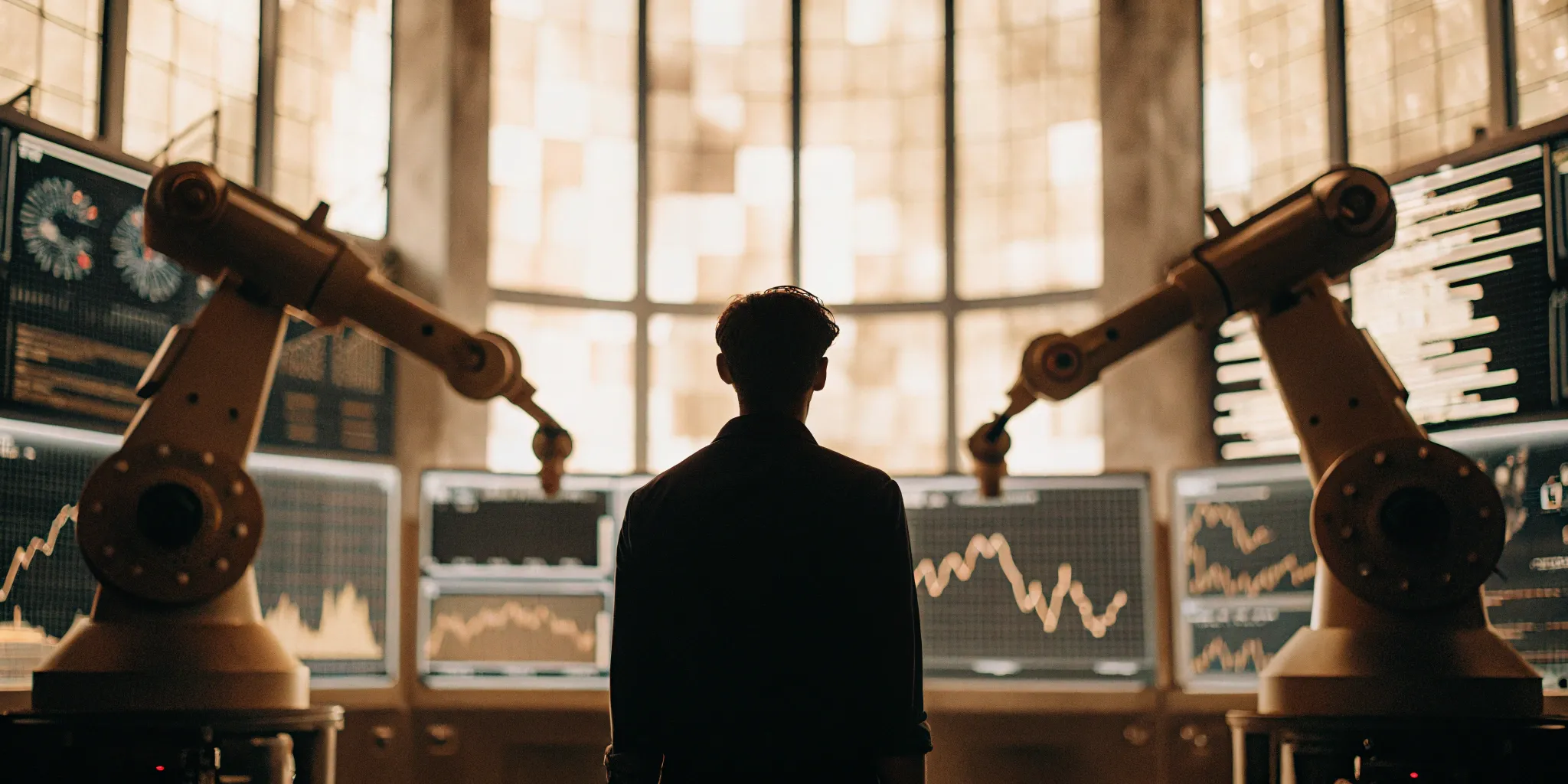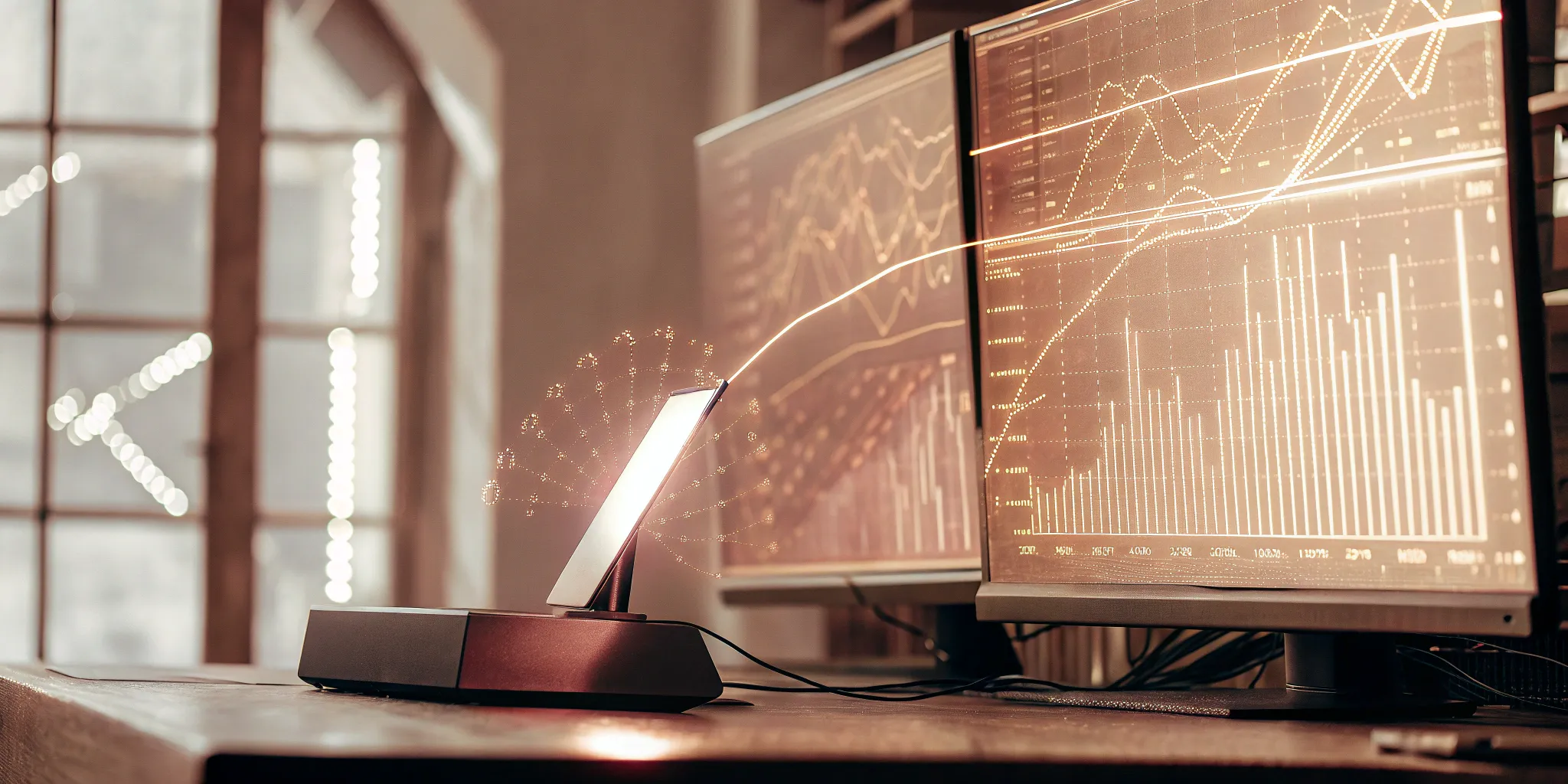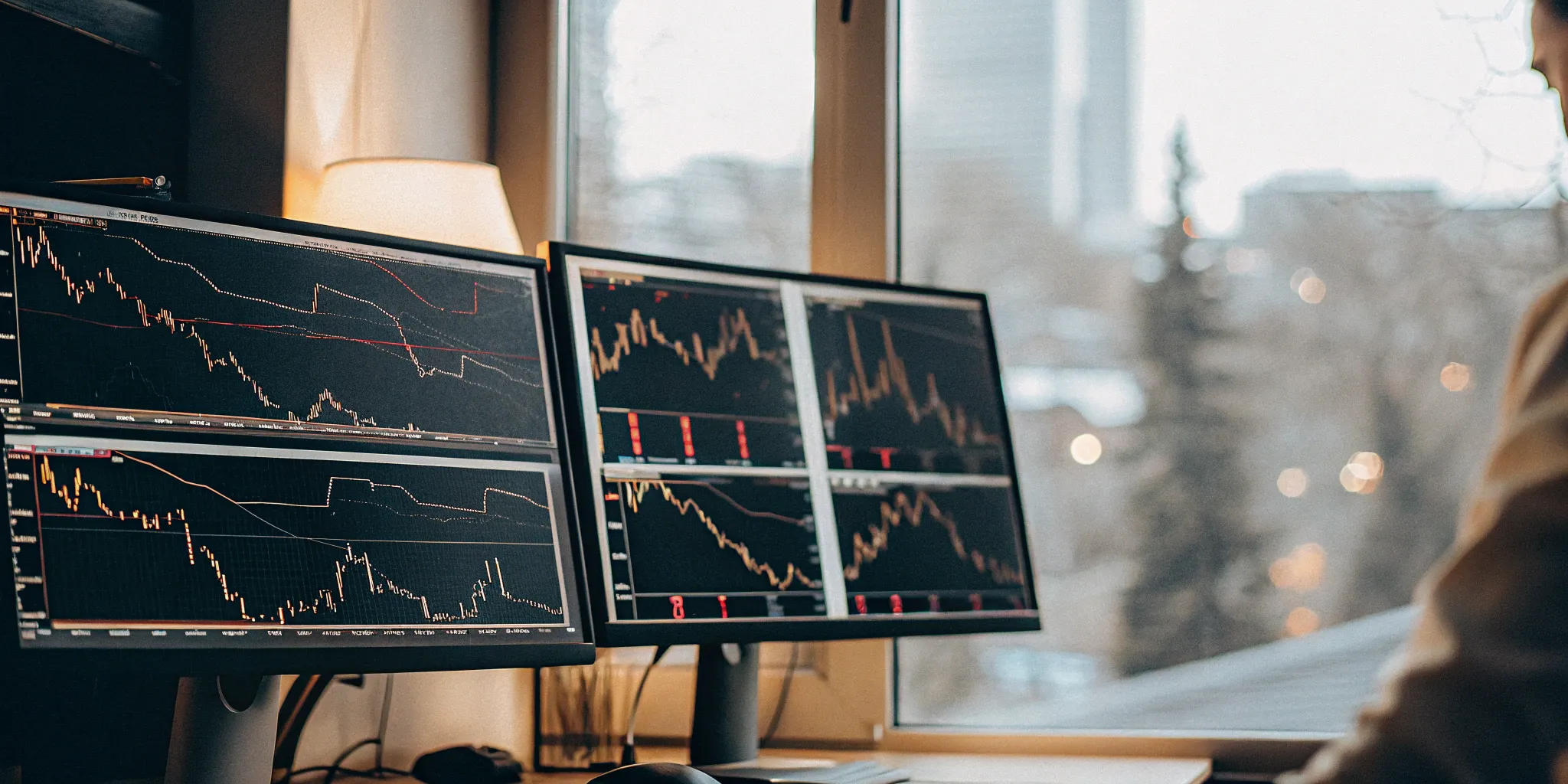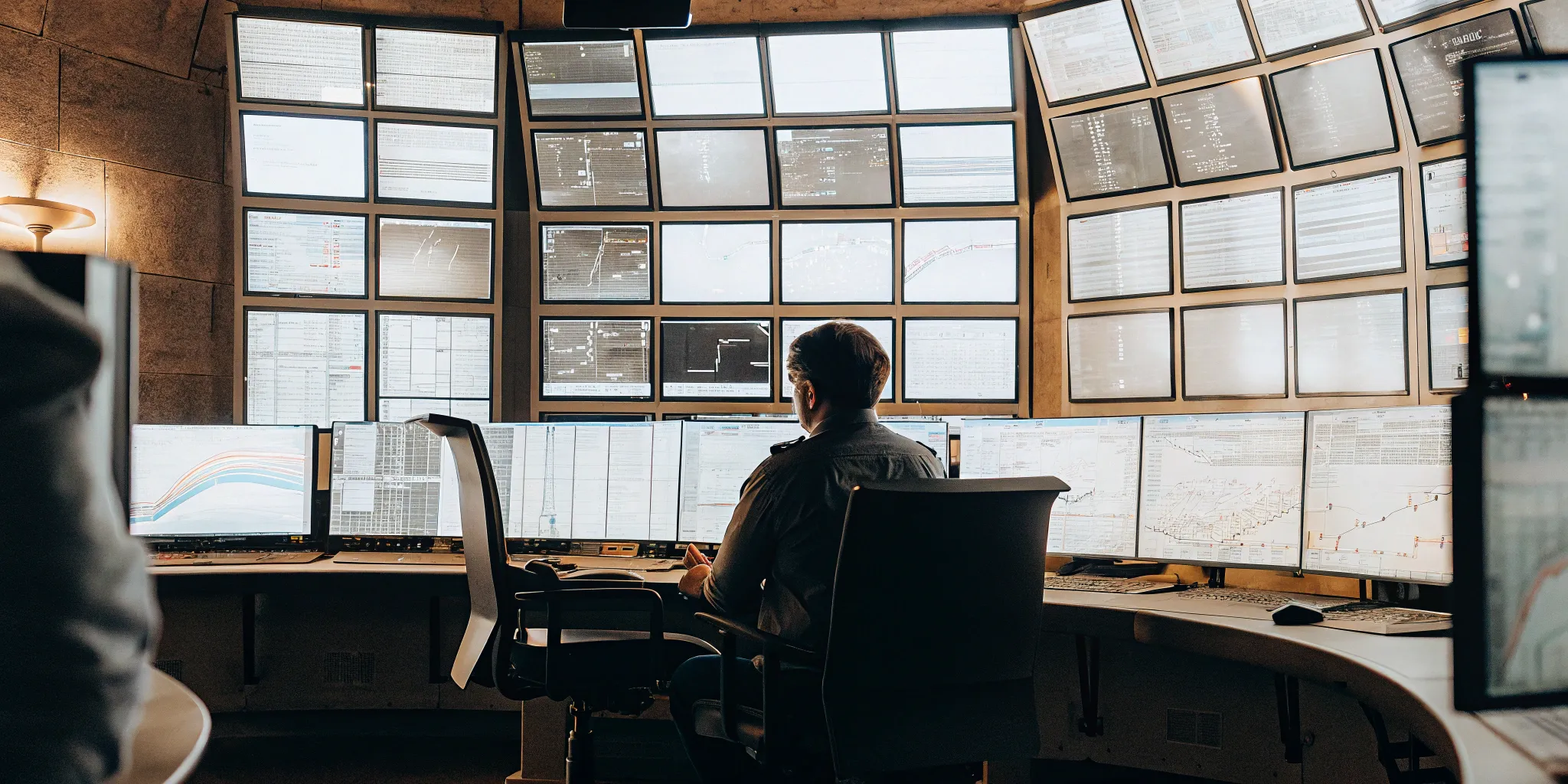The financial markets have already changed. While many people still picture trading floors packed with shouting traders, the reality is that the majority of trades are now executed by algorithms. This isn’t a future trend; it’s the current standard. Understanding this shift is essential for anyone serious about growing their capital in today’s environment. Relying solely on manual methods means you’re competing against systems that operate 24/7 without fatigue or emotion. This guide explains the technology behind AI-powered algo trading 2025, showing you how these systems analyze data, manage risk, and provide the disciplined edge needed to perform consistently in modern markets.
Key Takeaways
- Trade with Data, Not Emotion: AI’s core advantage is executing trades based on pure logic, removing the emotional biases like fear and greed that sabotage manual trading. It operates with a level of speed and discipline that is impossible for a person to maintain.
- Demand Proof, Not Promises: A trustworthy AI trading system shouldn’t be a “black box.” Look for solutions that offer a publicly verified track record and transparent risk controls, allowing you to verify performance instead of relying on blind faith.
- Leverage AI Without the Learning Curve: You don’t need to be a programmer to use AI trading. The most effective path is to partner with a professionally developed system, giving you immediate access to institutional-grade technology without the years of learning required to build it yourself.
What is AI-Powered Algorithmic Trading?
Let’s break it down. At its core, algorithmic trading uses computer code to automatically buy and sell assets based on a pre-set list of rules. Think of it as creating a detailed game plan for the market and then letting a program execute it with perfect discipline, removing the guesswork.
Now, let’s add the “AI” part. This is where it gets powerful. Instead of just following a fixed script, AI-powered systems can think, learn, and adapt. They use sophisticated quantitative trading models to analyze massive amounts of data in real-time—far more than any human could process. This includes everything from complex market trends and economic reports to breaking news and even social media sentiment. By identifying subtle patterns across these sources, the AI can spot potential trading opportunities that would otherwise go unnoticed.
The real advantage here is moving from simple automation to intelligent execution. An AI trading system doesn’t get tired, it doesn’t get emotional, and it certainly doesn’t “panic sell.” It operates purely on data and logic, capable of executing thousands of trades with a level of speed and precision that’s physically impossible for a person. This is how systems like our FAST AI work to deliver consistent performance—by taking the single biggest risk factor, human emotion, completely out of the equation.
AI vs. Manual Trading: What’s the Difference?
Choosing between AI and manual trading is about deciding how you want to approach the market. Think of it like this: you can either navigate with a paper map based on your own interpretation, or you can use a sophisticated GPS that analyzes real-time traffic, road closures, and weather patterns to find the best route. Both can get you there, but one is built for a level of efficiency and precision the other simply can’t match.
The most obvious difference is speed. A human trader can react and click “buy” or “sell” in a second or two. In that same time, an AI trading system can analyze millions of data points and execute thousands of trades. This isn’t just about being fast; it’s about capitalizing on tiny market movements that are invisible to the human eye. While a manual trader studies a few charts, AI for trading sifts through global news, market sentiment, and historical trends to inform its decisions.
Beyond speed, the biggest advantage of AI is the removal of emotion. Every manual trader, no matter how disciplined, has felt the pull of fear or greed. These emotions can lead to impulsive decisions, like selling too early during a dip or holding a losing position for too long. AI operates without bias. It follows its programming and executes trades based on pure data and logic, 24/7. This creates a foundation for more consistent, data-driven quantitative strategies that aren’t swayed by a bad day or market panic. While human intuition has its place, AI provides the unwavering discipline needed to execute a strategy flawlessly over the long term.
The AI Technologies Driving Modern Trading
When we talk about “AI” in trading, we’re not referring to a single piece of technology. It’s more like a powerful toolkit where different types of artificial intelligence work together to analyze markets and execute trades. Each component plays a unique role, from understanding breaking news to learning from past performance. At FN Capital, our FAST AI system integrates these advanced methods to create a comprehensive and adaptive trading solution that removes human emotion from the equation.
Understanding these core technologies gives you a clearer picture of what’s happening behind the scenes. It’s not about replacing human insight but augmenting it with a speed and data-processing power that’s simply beyond our capabilities. Let’s break down the key AI drivers that are shaping the future of trading and delivering consistent results. These are the engines that power modern, automated investment strategies and help you achieve your financial goals without being glued to a screen.
Deep Learning and Neural Networks
Think of deep learning and neural networks as the analytical “brain” of a trading AI. These systems are designed to mimic the human brain’s structure, allowing them to process and find patterns in enormous volumes of data. While a human trader might track a few dozen data points, a neural network can analyze thousands simultaneously—from price movements and trading volumes to complex economic indicators. This is how an AI can spot subtle, high-probability trading opportunities that a person would almost certainly miss. By constantly learning from market data, these systems perform a deep investment analysis to identify low-risk entry and exit points in the market.
Natural Language Processing (NLP)
Markets don’t just move on numbers; they move on news, announcements, and human sentiment. This is where Natural Language Processing (NLP) comes in. NLP is a branch of AI that gives machines the ability to read, understand, and interpret human language. In trading, this means the AI can analyze breaking news articles, central bank statements, and financial reports in real time. By applying NLP, a trading algorithm can gauge market sentiment—is the tone of a news release positive or negative? This adds a critical layer of context to the AI’s quantitative analysis and is a key part of modern risk mitigation strategies, allowing the system to react instantly to market-moving events.
Reinforcement Learning
If deep learning is the brain, reinforcement learning is how the AI gets smarter through experience. This technology allows an algorithm to learn through trial and error. The AI is programmed to achieve a specific goal, like maximizing profit while minimizing risk. When it makes a successful trade, it receives a virtual “reward.” When it makes a losing trade, it gets a “penalty.” Over millions of trades, the system refines its strategy to chase more rewards and avoid penalties. This continuous feedback loop helps the AI adapt its behavior to live market dynamics. It’s a powerful, self-improving mechanism that is proven by a long, verified track record.
The Rise of Quantum Computing
Looking ahead, the next frontier for AI in finance is quantum computing. While still in its early stages, quantum computing promises to deliver processing speeds that are exponentially faster than even the most powerful supercomputers today. This leap in computational power will allow AI systems to solve incredibly complex problems that are currently out of reach. For trading, this could mean running more sophisticated market simulations and optimizing massive portfolios with unprecedented speed. While not yet mainstream, the development of quantum computing is on the radar of every forward-thinking financial firm, promising to further enhance the AI trading systems we use today.
Why Use AI in Your Trading Strategy?
If you’ve ever felt overwhelmed by charts or second-guessed a trade, you already understand the limits of human emotion and endurance in the market. AI trading isn’t about replacing your judgment; it’s about enhancing it with speed, data, and discipline that operate beyond human capacity. By automating the heavy lifting, AI allows for a more strategic and less emotional approach to growing your capital, whether you’re a seasoned pro or just getting started.
Make Smarter Decisions with Better Data
The financial markets generate an incredible amount of information every second. For a human trader, processing all of it is impossible. AI, on the other hand, thrives on it. It uses powerful algorithms to analyze massive datasets in real time—sifting through market trends, news reports, and social media sentiment to spot opportunities a person might easily miss. This ability to make sense of complex information allows for more informed, data-driven trading decisions. Instead of relying on gut feelings, you can depend on a system built to find high-probability setups based on what the data is actually saying. This is how AI provides a true analytical edge in big data investing.
Manage Risk in Real Time
One of the biggest challenges in trading is managing risk, especially when the market gets volatile. An AI-powered system doesn’t get scared or greedy. It sticks to the plan. Advanced systems can adapt to changing market conditions instantly, adjusting positions and managing exposure based on predefined rules. At FN Capital, our proprietary DART (Dynamic Algorithmic Risk Tool) is designed for exactly this purpose. It continuously monitors the market to optimize position sizes and stop-losses, providing a layer of automated risk mitigation that works around the clock to protect your capital. This removes the emotional guesswork that so often leads to costly mistakes.
Trade Faster and More Efficiently
In today’s markets, speed matters. A delay of even a fraction of a second can be the difference between a profitable trade and a missed opportunity. AI executes trades with incredible speed and precision, eliminating the hesitation that can come with manual trading. It operates on pure logic, executing orders the moment its criteria are met. This efficiency is why experts predict AI will soon handle the vast majority of global trades. By leveraging quantitative trading models, AI can perform high-frequency trades without fatigue, ensuring that your strategy is always active when the right conditions appear, 24 hours a day.
Adapt to the Market 24/7
The market never truly sleeps, and neither does AI. While a human trader needs to rest, an AI trading system is always on, always learning, and always adapting. It can monitor global markets across different time zones, ensuring you never miss an opportunity just because it happened overnight. This constant evolution is a core strength of AI in trading; it’s not a static “set and forget” tool. The system learns from complex patterns and refines its approach over time, aiming for consistent performance. This gives you a hands-free, fully automated investment engine that works for you even when you’re focused on other things.
Understanding the Challenges in AI Trading
As powerful as AI trading is, it’s not a hands-off process without its own set of hurdles. Thinking that you can just switch on an algorithm and walk away is a common misconception. The reality is that the world of automated trading is filled with complexities that require sophisticated solutions. For investors, knowing what these challenges are is the first step toward choosing a partner who has already figured out how to solve them.
The main challenges fall into a few key areas. First, there’s the ever-changing web of financial regulations, which is still catching up to the technology. Then there’s the issue of transparency—if an AI is making thousands of decisions a minute, how do you know you can trust its logic? Markets are also famously unpredictable, and any system needs to be able to handle sudden shocks without faltering. Finally, it all comes down to the quality of the data and the reliability of the system executing the trades. An AI is only as smart as the information it receives. Addressing these issues head-on is what separates a professional-grade AI trading solution from a risky gamble.
Keeping Up with Regulations
The financial industry is one of the most heavily regulated sectors in the world, and for good reason. When AI enters the picture, regulators get even more cautious. The rules governing AI in trading are constantly evolving, and staying compliant is a significant challenge. There are serious concerns about ensuring fairness, preventing market manipulation, and making sure automated systems don’t introduce new risks. For an individual investor, this landscape is almost impossible to manage on your own.
This is why working with a firm that operates within a clear legal framework is so important. At FN Capital, we use a structure involving a Third Party Fund Administrator (TPFA) that allows our clients to access international brokers seamlessly and in full compliance. This model handles the regulatory friction, so you can focus on your investment goals without worrying about the legal complexities of global investment trends.
The “Black Box” Problem: What’s Happening Inside the AI?
One of the biggest hesitations people have about AI is the “black box” problem. It can be difficult to understand exactly how a complex algorithm arrives at its decisions. If you don’t know why a trade was made, it can be hard to build trust in the system, especially when your capital is on the line. This lack of transparency is a valid concern and a major hurdle for many AI platforms that fail to offer clarity.
We believe the antidote to fear is transparency. While the inner workings of our FAST AI are proprietary, its performance is not a secret. We provide a publicly verified 4-year track record on FX Blue, showing every trade, the win rate, and the overall returns. Instead of asking you to blindly trust an algorithm, we give you the data to verify its results for yourself. This turns the black box into a clear one, where performance and consistency speak for themselves.
Handling Sudden Market Shifts
Markets can turn on a dime. A surprise announcement or unexpected global event can send prices swinging wildly in seconds. A key challenge for any trading strategy is how it responds to these sudden shifts. A rigid, rules-based algorithm might fail during extreme volatility, while a human trader can be too slow or emotional to react effectively. An AI needs to be both fast and smart enough to adapt without making critical errors.
A well-designed AI can adapt to changing market conditions far better than simpler automated systems. Our FAST AI is equipped with a proprietary Dynamic Algorithmic Risk Tool (DART) that acts as a real-time defense mechanism. DART continuously analyzes market volatility and automatically adjusts trade sizes, leverage, and stop-losses to protect capital during turbulence. This built-in risk mitigation ensures the system is always prepared for the unexpected, protecting your investment when it matters most.
Ensuring Your Data and Systems Are Reliable
In trading, an old saying holds true: bad data leads to bad decisions. An AI trading system is completely dependent on the quality and speed of the data it receives. Any inaccuracies, delays, or gaps in the data feed can cause the algorithm to make flawed trades, undermining the entire strategy. This is why institutional-grade infrastructure is not a luxury—it’s a necessity for consistent performance.
Our entire system is built on a foundation of reliable data and execution. We focus exclusively on the EUR/USD pair, the most liquid forex market in the world. This ensures we receive a clean, deep, and stable stream of data with minimal slippage or gaps. By combining high-quality data with Tier-1 institutional liquidity, we provide our FAST AI with the accurate information it needs to perform quantitative trading effectively. This meticulous focus on data integrity is fundamental to achieving consistent, verifiable results.
The Platforms and Tools You Should Know
The world of AI trading is filled with platforms and tools, each designed for different goals and levels of expertise. Finding the right fit depends on whether you want to be hands-on with your strategy or prefer a fully automated approach. Let’s look at some of the key players across different market segments.
Platforms for Individual Investors
If you’re an individual investor who enjoys building and testing your own strategies, platforms like Trade Ideas, MetaTrader 5, and Alpaca offer a suite of tools for leveraging AI. These are great for traders who want to get their hands dirty with technical analysis and algorithm creation. On the other hand, if you’re looking for a more hands-off experience, a fully automated system might be a better fit. Solutions like ours at FN Capital are designed for retail investors who want to benefit from AI trading without the steep learning curve, letting the algorithm do the heavy lifting for you.
Solutions for Institutions and Funds
For large-scale operations like hedge funds and financial institutions, the demands are far more complex. Platforms such as the Bloomberg Terminal and Kensho provide the advanced, data-heavy analytics these organizations need to manage massive portfolios. These systems are the gold standard for institutional-grade insights. At the same time, firms can access powerful quantitative trading solutions without building a proprietary system from scratch. FN Capital provides an institutional-grade framework that integrates directly with brokers, offering a streamlined way to deploy sophisticated AI strategies at scale.
AI Tools for the Crypto Market
The cryptocurrency market moves fast, and a number of AI-powered tools have emerged to help traders keep up. Platforms like 3Commas, Coinrule, and Cryptohopper are popular for automating trading strategies specifically for digital assets. These tools are built to handle the unique volatility of crypto. While they serve a specific niche, other AI systems focus on more traditional markets for greater stability. For example, our FAST AI algorithm exclusively trades the EUR/USD pair, leveraging its massive liquidity to ensure precise and efficient execution, as shown in our verified track record.
How AI is Changing the Financial Markets
Artificial intelligence isn’t just a concept from a sci-fi movie; it’s actively rewiring the engine of global finance. The classic image of a trading floor, buzzing with people and paper, is quickly being replaced by servers running sophisticated algorithms that execute trades with a speed and precision that was once unimaginable. This evolution is creating a more efficient, data-driven, and accessible market for everyone, from individual investors looking for passive income to large-scale institutions.
The heart of this transformation is AI’s ability to analyze massive datasets in real time, spotting patterns and opportunities that are simply invisible to the human eye. It can operate around the clock without emotion, fatigue, or the behavioral biases that often lead to poor decisions. This isn’t about replacing human strategy, but about augmenting it with an incredibly powerful tool. At FN Capital, we’ve built our FAST AI algorithm on this principle, giving our clients direct access to the institutional-grade technology that is shaping the future of trading.
Shifting Market Structures
The scale of AI’s impact on the markets is already immense. Algorithmic trading isn’t a niche strategy anymore; it’s the dominant force, with some reports indicating it handles around 70% of all US stock trades. This isn’t a slow transition—it’s a fundamental change in how markets operate. The reason is simple: AI can process news releases, economic reports, and market sentiment in milliseconds, making data-driven decisions faster than any person can. This speed is crucial in markets like forex, where liquidity and timing are paramount. By focusing on high-volume pairs like EUR/USD, AI can execute thousands of trades with minimal slippage, an advantage that used to be exclusive to the biggest financial firms.
How Humans and AI Can Work Together
It’s easy to hear all this and wonder if AI is making the human trader obsolete. The reality is much more of a partnership. Think of AI as an incredibly skilled co-pilot, not an autonomous replacement that has completely taken over. While AI excels at sifting through data and executing trades without emotional interference, it still operates on the strategies and rules designed by people. Its success is tied to the quality of its algorithms and the data it learns from. This is where human expertise is irreplaceable—in building, testing, and overseeing these complex systems. An AI can analyze massive amounts of data to find opportunities, but it’s the human-led strategy that guides its purpose. Our approach with our robo-advisor solutions embodies this synergy, offering a system where our experts have already built and refined the AI, allowing you to benefit from its power without needing a degree in data science.
How to Get Started with AI Trading
Getting started with AI trading doesn’t mean you have to become a programmer overnight. Your first real decision is whether you want to build your own trading bot or use a professionally developed, hands-off solution. While the DIY approach can be a fascinating project, it demands a significant investment of time and a deep understanding of both coding and financial markets. For most investors—from beginners to seasoned pros—partnering with a platform that has already perfected its technology is the most direct path to the markets.
This lets you leverage the power of AI without the steep learning curve. Think of it as choosing between building a race car from scratch or hiring a professional racing team. One lets you get on the track immediately. A ready-made system allows you to focus on your financial goals while the AI handles the complex, high-speed execution. It’s a practical way to access institutional-grade technology and begin your journey with AI-powered trading today.
Skills to Develop for AI-Driven Markets
If you’re interested in building your own system, be prepared to develop a unique skill set. A successful AI trading bot requires expertise in both finance and programming. You’ll need to understand market dynamics, statistical modeling, and be proficient in a language like Python to design algorithms that can find opportunities humans might overlook. This path is rewarding but intense. For everyone else who wants the results without the years of training, a solution like FN Capital is designed to close that gap. Our FAST AI system is ready to go, letting you tap into expert-level trading from day one.
Evolve Your Investment Strategy
Adopting AI is less about learning to code and more about evolving your investment mindset. It means trusting a system that uses advanced algorithms to analyze massive amounts of data with a speed and accuracy that’s impossible to replicate manually. Instead of reacting to yesterday’s news, you’re using a tool that works to anticipate market movements based on complex patterns. As AI gets smarter with deep learning and NLP, this advantage will only increase. Shifting your strategy from emotional decisions to a data-driven approach is the key to unlocking disciplined, consistent performance in modern markets.
The Ethics and Future of AI in Trading
As AI becomes a more powerful force in the financial world, it’s natural to ask about the rules of the road. With any powerful technology, responsible development is key to building trust and ensuring the system works for everyone. The conversation around AI ethics is not just important—it’s essential for creating long-term stability and fairness in trading.
One of the most discussed topics is what’s known as “the black box problem.” This happens when an AI model is so complex that even its creators can’t fully explain why it made a specific decision. For trading, this lack of transparency can be a real concern. It makes accountability difficult and highlights the need for systems that are both intelligent and interpretable. This is why responsible firms prioritize clear performance metrics and risk controls, so you always have a clear view of what the AI is doing and how it’s being managed.
Beyond transparency, there’s the critical need for strong oversight to prevent market manipulation and ensure fair and stable markets. As AI systems become more capable of executing thousands of trades, clear regulations help guarantee that the technology is used to create opportunities, not to exploit loopholes. At FN Capital, we operate within a structured legal framework and use tools like our DART system to maintain ethical standards and protect our clients’ capital.
Ultimately, AI is an incredibly powerful tool, but it’s not perfect. Like any technology, it can make mistakes, which is why it’s best used to assist, not fully replace, human judgment. The future of trading isn’t about handing everything over to a machine; it’s about creating a partnership where human strategy guides AI execution. As technology continues to advance with deep learning and even quantum computing on the horizon, this focus on responsible innovation will remain the cornerstone of sustainable success.
Related Articles
- How AI Trading Works: Strategies & Benefits
- Algorithmic Trading Software 2025 Guide: Key Insights
- Algorithmic vs. Manual Trading: Which Is Best? – FN Capital
- Understanding AI Trades: A Practical Guide for Investors – FN Capital – Like a Cash Account, But Smarter
Frequently Asked Questions

How can I be sure your performance numbers are real? We believe that trust is built on transparency, not just talk. That’s why we don’t just show you a curated spreadsheet of our best results. Instead, we provide a direct link to our live, four-year performance record on FX Blue, a trusted third-party verification service. This gives you an unfiltered, real-time view of our trading history, so you can see every trade and verify our track record for yourself.
What happens if the market gets extremely volatile? How is my money protected? This is one of the most important questions you can ask. Our system is built with a proprietary risk-management tool called DART, which acts as a dynamic shield for your capital. It constantly analyzes market volatility and automatically adjusts trade sizes and exposure during sudden shifts. It’s designed to be defensive when it needs to be, prioritizing capital preservation over chasing risky profits in an unstable market.
Do I need to be a trading expert to use this? Absolutely not. Our system was designed to be a hands-free solution for everyone, regardless of their experience with financial markets. Once you’re set up, our FAST AI handles all the trading and analysis for you. You can monitor your account’s progress whenever you like, but you don’t need to know how to read charts or make trading decisions. We’ve done the complex work so you can focus on your goals.
Why does your AI only trade the EUR/USD currency pair? We focus on EUR/USD for one simple reason: discipline. It’s the most traded currency pair in the world, which means it has incredible liquidity. This allows our AI to execute trades with maximum speed and minimal slippage, which is critical for a high-frequency strategy. By mastering one market instead of being average in many, our AI can maintain a consistent and specialized edge.
What is a TPFA and why do I need one to get started? A Third Party Fund Administrator, or TPFA, is an independent company that helps streamline the investment process, especially for our international clients. It acts as a secure gateway, allowing you to access top-tier international brokers that might otherwise be unavailable due to regional restrictions. This structure handles the regulatory complexities for you, ensuring a smooth and compliant way to fund your account and put our AI to work.





